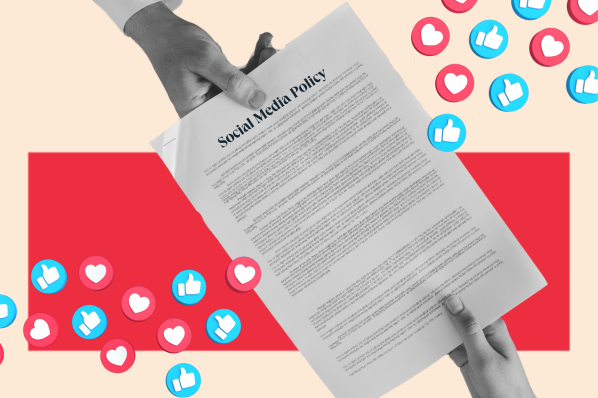Segmentation is important because it increases your marketing success. When you know the key characteristics and desires of your target audience, you can become more focused with your brand messaging and create hyper-targeted advertisements that speak directly to your audience's interests. Then, when your advertisements are tailored to their interests, customers are more likely to interact with them and take further action.
Let’s go over eight strategies for segmenting your social media audiences.
1. Understand your audience.
Just as with any marketing strategy, understanding your target audience is the key to accurate, relevant social media segmentation. Without knowing who your customers are, what they want, and how they like to be marketed too, it will be challenging to devise other strategies to help you succeed in your process.
To better get to know your audience, you can create buyer personas from your analytics and research data. Buyer personas are semi-fictional representations of your ideal customers that help you focus your time on qualified prospects, attract high-value customers, and create content that best speaks to their interests and desires.
You can think of it like this: if the data you’ve collected shows you that Facebook brings you the most engagement, dig deeper into who your audience is on that platform and create a buyer persona that brings a more comprehensive understanding of who they are. These representations you’ve created directly relate to our next tip, as many social media platforms come with audience targeting tools that you can use to market specifically to your different segmented audiences.
2. Use native social media targeting tools.
When most people think of social media segmentation, they think of paid targeting options. However, for low and high budget marketers alike, there are organic targeting options on different platforms that you can use to speak to your various audiences.
For example, Facebook allows businesses to target their messages to users based on demographics, interests, and geographical location (as shown below).

On LinkedIn, there are also built-in targeting tools that allow you to filter and segment by industry, company size, and much more (shown below).
3. Create audience groups.
Social media is all about community. Building communities of people who share common interests is an easy way to segment your audience and gain valuable insights. You may decide to keep the group open (anyone can join) or closed (a moderator must approve new members), and there are advantages to each.
Open groups enable you to gather information about how a more general audience feels about your brand. You can use this forum to have discussions and ask open-ended questions such as, “What are your biggest challenges?” or “What makes excellent customer service?” You can also test new ideas with your audience members or discover new content ideas that they would find interesting and relevant. The advantage here is that you will have a large group to bounce ideas off of. The disadvantage? They may not be as knowledgeable about your industry as you need.
That's where closed groups can come in handy. You are approving each member's admission to the group, and you can cherry-pick the most qualified candidates. Maybe they're a group of customers whose opinions you value or a list of people who have attended an event you've hosted. Regardless of admission requirements, this can be a great way to get specific, helpful feedback from a group you trust — but you may not get as many responses as an open group discussion.
Various social media platforms have group functionalities, specifically Facebook and LinkedIn. On Facebook, you can create a group that is relevant to your business and your target audience’s interests that can be public or private, as mentioned above. The same can be said for LinkedIn, but you should only opt to use it if your target audiences are professional-aged, business minded individuals.
4. Create audience lists.
Most marketers are familiar with creating lists — we do that every time we send a new email campaign. But did you know you can use lists to have more productive social media conversations? Social networks like Facebook and Twitter allow users to create lists of friends, followers, people who have attended an event, and more.
On Twitter, your lists can separate followers into specific categories, like where they are in their buyer’s journey. Whenever these people in your lists Tweet, you’ll be able to view them all within a specific channel to get an idea of what kinds of things they tweet about and what they enjoy. When you have this information, you can create better-targeted ads that speak to your segmented audience’s preferences.
If you’re a HubSpot customer, the lists you use for your email can actually be one and the same as your social monitoring lists. You can set up a stream for each one of your buyer personas, such as a stream for leads who are talking about your brand, or customers in a certain industry. You’ll spend much less time trying to filter through the noise, and much more time having relevant, targeted conversations.
5. Post at different times of the day.
As marketers, we know how important timing is to marketing — especially on social media. If you’ve created accurate, relevant buyer personas, you’ll likely realize that your followers are distributed throughout different geographic regions. This means that your followers in the central United States are going to bed while your followers in Australia are getting ready to wake up.
Differentiating your publishing times allows you to generate engagement from a larger portion of your audience, as followers from all over the world have the opportunity to engage with your posts.
An additional benefit to doing this is that you’ll have multiple posts out there for your target audience to see. You can think of it like this: if you post three times throughout the day for three different audience segments, each one of those segments can also see the posts meant for the other. Three more opportunities for them to interact with your content and three more chances to drive conversions.
6. Leverage multiple networks.
As you master the various ways to segment your specific audiences, more people will be interested in connecting with you through social media. If you don’t already run multiple social media accounts, you may realize that one of the best ways to serve relevant content to specific audiences is to create several social media profiles, each with specific intent.
For example, if you’re a clothing brand, your target audience is likely widely dispersed age-wise. While you may hope to reach all of them on one platform, you’re more likely to get your younger audiences (aged 10-19) on TikTok and your older audiences on Instagram.
Additionally, within each of those different platforms, it’s also worth considering creating multiple accounts focused on various aspects of your business or the demands of your different audiences. At HubSpot, we maintain more than five different Twitter accounts to provide content relevant to each segment of our audience. For example, @HubSpotAcademy is a channel that marketers can use to learn how to be a better inbound marketer, while @HubSpotSupport is a channel that our customers can use to get help using the HubSpot platform. Both Twitter accounts are relevant to anyone interested in HubSpot, but they are most relevant to their particular segments.
Keep in mind that each social media account should still serve a larger audience, so be sure to work on building your overall audience from one account before you try building out more. If you decide to start building out more accounts, be sure that people can easily differentiate their purpose (ex: customer support, marketing materials, your yearly event, etc.) — otherwise, you'll be creating more work for yourself.
7. Streamline your processes.
Should you choose to leverage multiple platforms or simply just want to streamline your processes, there are various social media tools that can help you create and publish advertisements built for your segmented audiences.
Falcon.io is one of those tools. It comes with an all-in-one social platform for creating paid and organic advertisements, managing customer engagement data from all your accounts, and even creating custom and lookalike audiences for further segmentation, as displayed by the image below.

8. Test your strategies.
Although this tip is not directly related to grouping your audience, the success of your segmentation depends on how well you’ve created your groups. Using social media testing as a means of understanding how your content is performing among your target audiences is a way to know if you’ve accurately segmented your audience, and it can help you perfect your strategy.
For example, say you’ve found your millennial audience to be most active on Instagram. You know that they’re there, so you can begin creating content for them. However, what if you want to better understand their preferences? Maybe you want to know whether they prefer Instagram Stories or Instagram Reels? Conducting an A/B test with both of these content types will help you better understand how to communicate with these segmented groups.
Speak To Your Different Audience Groups
Unless you’re a very niche business, you likely have a large audience group. Within these audience groups, there are probably other distinct communities with different preferences and desires.
It may be challenging to figure out how to tailor your message to individually speak to all of your diverse customers, but the eight tips mentioned above will help you carefully segment your social media audience for more relevant conversations — and eventually, more conversions.
Social Media Strategy




![The most effective types of content on social media in 2025 [new data]](https://53.fs1.hubspotusercontent-na1.net/hubfs/53/Copy%20of%20Featured%20Image%20Template%20Backgrounds%20(16).png)


-1.jpg)
.png)
![How to Create a Great Social Media Strategy in 2025 [+ New Data]](https://53.fs1.hubspotusercontent-na1.net/hubfs/53/social-media-strategy.webp)



